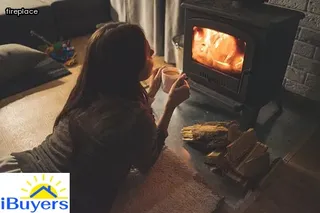Properly maintaining a chimney flue is essential to both the safety and efficiency of your home’s heating system. Identifying common issues with the flue can help you determine the most effective way to repair cracked tiles.
Common issues that require attention include cracks, rust, sink holes, gaps in mortar joints, and missing or broken tiles. These issues are often caused by extreme weather conditions such as freezing temperatures, high winds or heavy rain.
If left untreated, these cracks can worsen over time and allow dangerous gases and smoke to enter the home. Additionally, if water seeps into the crack it may expand and cause further damage to the surrounding area.
It is important to identify any cracks in your chimney flue tiles early on so that they can be repaired quickly and effectively. This will help ensure that no additional damage is done while also preventing any hazardous materials from entering your home.
The most effective way to repair cracked tiles will depend on the severity of the crack but could involve replacing individual tiles or performing a full rebuild of the chimney flue itself.

Inspecting your clay tiles for cracks and other signs of damage should be a regular part of your chimney maintenance routine. Clay flue tiles can become cracked over time due to weather and extreme temperatures, so it is important to inspect them regularly for any signs of damage.
Begin by looking in the firebox of the chimney for any broken pieces or evidence that the bricks have shifted. Next, carefully feel around each tile with a gloved hand to check for any chips or cracks that may have formed.
If you find any damaged tiles, they should be replaced as soon as possible to ensure that the entire chimney flue is secure. To repair cracked clay flue tiles, use a heat-resistant mortar mix that is specially formulated for masonry repairs.
Apply the mortar directly on top of the cracked tile and then press new tiles into place. The heat-resistant mortar will provide a strong bond between the replacement tiles and existing structure, ensuring a secure hold even in high temperatures.
The condition of your chimney flue should be assessed regularly to ensure it is in good repair. Cracked flue tiles can cause smoke and other hazardous gases to leak into the home, creating a dangerous environment.
The most effective way to repair cracked chimney flue tiles is to seal and caulk the area with a fire-resistant compound. It is important to hire a professional to inspect your fireplace and chimney annually, as cracks can form quickly due to normal wear and tear, exposure to weather conditions, or age-related deterioration.
If any loose or broken pieces are found, they must be removed before continuing with the repair process. Once the damaged area has been identified, it is essential that you use the correct type of materials for repair that are designed for use around fireplaces and chimneys.
These products will provide heat resistance and help keep the heat from escaping through the crack in the tile. With proper maintenance, your chimney's flue tiles should last for many years without needing repairs again.

When it comes to repairing clay tiles that are cracked in the chimney flue, there are many options available to homeowners. The most effective way is to use a mortar-based patching compound.
This type of material provides a strong bond that can last for years and can be easily applied with an adhesive gun. Additionally, if the crack is small enough, a silicone sealant may be used as well.
This method requires minimal effort as the sealant can simply be spread over the cracked area with a putty knife or brush. A third option is to replace the damaged tiles with new ones.
However, this method can be time consuming and costly if multiple tiles must be replaced. Furthermore, in order to ensure a proper fit and prevent future cracks, it is important to use clay tiles that have been properly cured and fired before installation.
Whichever method you decide on, make sure you follow manufacturer instructions carefully for best results.
Cracked clay tiles in a chimney flue can create a hazardous environment if not repaired properly. Clay tile repair is an essential part of maintaining a safe and functional chimney system and requires some specialized tools and materials.
The most effective way to repair cracked clay tiles is to first inspect the entire chimney and determine the extent of the damage. Once the damage has been assessed, it's important to clean out any debris or dust from the flue before beginning repairs.
For minor cracks, use a metal patching compound and adhesive to fill the gap between tiles. For more serious damages, you may need to replace individual tiles with new ones that match the existing style and color.
Finally, make sure all new tiles are securely attached with mortar or other strong adhesive material for maximum protection against future cracking. With proper care and maintenance, your chimney flue should remain safe and in good condition for many years to come.

When it comes to repairing a cracked chimney flue tile, it is important to take the right approach. The most effective way to fix a single cracked tile is to replace the tile with a new one.
This should be done as soon as possible in order to prevent further damage and minimize potential risks. It is essential to first assess the extent of the damage before attempting any repairs, as this will help decide which repair method is most suitable for your situation.
For example, if the crack is relatively minor, you may be able to fill the area with mortar or caulking material. However, for bigger cracks, it is best to replace the broken piece with an entirely new tile.
Additionally, you must ensure that all tiles are securely attached in order for them to properly protect against water leakage and other elements that may enter your home through the chimney. Furthermore, make sure you use tiles made from materials that are appropriate for your climate and region; clay tiles are best suited for dry climates while concrete tiles can withstand more humid environments.
Finally, having a professional inspect your chimney after repair work has been completed can provide peace of mind that everything has been done correctly and safely.
When it comes to repairing cracked chimney flue tiles, the most effective approach is to use a comprehensive strategy that addresses all areas of the flue. This means identifying any cracks and assessing their size and severity in order to determine how best to fill them in.
For larger cracks, a patchwork of materials such as cement, mortar or even metal mesh may be necessary. When filling smaller cracks, sealant or caulk is usually sufficient.
In cases where the cracking is extensive and has led to crumbling of the tiles, they should be replaced with new ones. Additionally, once the repairs are complete, waterproofing should be applied in order to protect against further damage from moisture and weather conditions.
By using this comprehensive approach for crack repairs, homeowners can ensure that their chimney flues remain safe and secure for many years to come.

When considering replacing cracked clay tiles in a chimney flue, there are several factors to keep in mind. One key factor is the type of tile used, as this will determine the best repair option.
Clay tiles are generally more durable and less prone to cracking than other types of tile, but they can still become damaged over time and require replacement. Additionally, it’s important to consider the age and condition of the existing tiles before deciding on a repair strategy.
If the existing tiles are old or worn, it may be more cost effective in the long run to replace them rather than attempting repairs. It's also important to make sure that any new tiles being installed are compatible with the existing flue structure, as incompatible tiles can lead to further damage down the road.
Professional chimney sweeps can provide assistance with selecting appropriate materials and inspecting flues for signs of wear and tear prior to beginning any repair work.
Replacing tile on a cement board subfloor is an effective way to repair cracked chimney flue tiles. First, the damaged area must be cleared of debris and dirt.
Next, a layer of mortar should be applied to the subfloor using a trowel. When this has dried, new tiles can be placed into the mortar-covered area.
Make sure to line them up in straight lines to ensure even distribution and levelness of the tiles. Furthermore, if you are using a tile adhesive, it should be spread over the back of each tile before placing them in place.
Once all of your new tiles have been laid down, they need to be grouted and sealed so that no moisture can get through them. This will help keep your chimney flue protected from future damage and give it a long lasting life span.

Cast-in-place liners are the most effective way to repair cracked chimney flue tiles, providing numerous benefits to homeowners. They are a permanent solution and do not require any demolition or removal of existing materials, allowing for a quick resolution to the problem.
In addition, cast-in-place liners are easy to install and can be done in a single day with minimal fuss. As they fit snugly within the old tile structure, they also help to create a watertight seal that will keep moisture from entering the home.
Furthermore, these liners offer superior strength and durability compared to traditional repairs such as patching or replacing broken tiles. The material used is heat resistant and fireproof, making it perfect for chimneys that experience high temperatures when fires are burning.
Lastly, because of their long lifespan and dependable performance, cast-in-place liners provide excellent value for money in the long run.
Stainless steel liners offer a highly effective way to repair cracked chimney flue tiles. This reliable material is one of the most popular choices for relining a damaged chimney and boasts an array of advantages over other materials.
Stainless steel liners are non-combustible and provide superior insulation, making them safer and more efficient than traditional clay tiles. These liners are corrosion-resistant, meaning they won't rust or deteriorate over time like other materials, ensuring your chimney remains safe from future damage.
Additionally, stainless steel liners are easier and quicker to install than other materials, allowing you to complete the repair process in less time. Furthermore, stainless steel is cost-effective compared to other liner materials due to its durability and long lifespan.
With these qualities in mind, it's easy to see why stainless steel is the preferred choice for repairing cracked chimney flue tiles.

When it comes to repairing a cracked chimney flue, two popular solutions are cast-in-place and stainless steel liners. Both methods have advantages and disadvantages that should be considered before making a decision.
Cast-in-place liners involve the pouring of a refractory mortar mixture into a damaged area, which then hardens and creates a permanent seal. This is often the most economical solution for minor damage, however it may not last as long as more expensive options such as stainless steel liner systems.
Stainless steel liners offer greater durability and protection against future damage, but they require professional installation and can be quite costly. Ultimately, the best way to repair cracked chimney flue tiles depends on the amount of damage, budget constraints, and desired longevity of the repairs.
When considering how to repair a cracked chimney flue tile, it is important to understand the pros and cons of popular materials. Clay tiles are a traditional choice for chimney flues and are durable, but if they crack, they can be difficult to replace without professional help.
Cast-in-place liners are made with lightweight refractory cement and provide a smooth interior surface which increases draft efficiency. However, the installation is complicated and expensive.
Stainless steel is an increasingly popular material for repairing chimney flues due to its durability and resistance to corrosion. It can also be installed relatively quickly, though cost is often prohibitively high compared to other materials.
Finally, flexible chimney liners are made from aluminum or stainless steel and are resistant to rusting or cracking. They are also easy to install but may not last as long as other materials.

When evaluating the age and durability of your chimney flue, it's important to inspect for any cracked tiles or other signs of damage. If you notice any cracks in the tiles, it is essential that you repair them as soon as possible to prevent further problems.
Repairing cracked flue tiles is best done by using a heat-resistant sealant, which can help stop smoke from leaking through the cracks and potentially causing other issues. It is also important to check for any loose mortar joints or gaps between the tiles and ensure they are sealed properly with a high-temperature sealant.
Additionally, it is beneficial to apply a thin layer of masonry waterproofing agent over the entire surface to minimize future damage due to moisture retention and freeze-thaw cycles. Lastly, by regularly inspecting your chimney flue for potential signs of wear and tear, you can ensure that it will continue functioning safely and effectively for many years to come.
Making wise decisions when replacing a cracked chimney flue tile is critical to the safety of any home. It's important to contact a professional certified chimney sweep to assess the damage, as they will have the experience and know-how to properly repair or replace the flue tiles.
It's also essential that the correct materials are used for the job, such as high-temperature ceramic tiles, so that it can withstand extreme heat from wood burning fires. Additionally, while rebuilding a chimney flue with ceramic tile can be a more expensive option, it may be worth spending extra on quality materials in order to ensure it lasts longer.
Furthermore, don’t forget that good insulation should also be installed in order to reduce energy costs and keep your home warm. Taking all these steps into consideration before repairing or replacing your chimney flue tiles can help you make an educated decision and keep your family safe.

Chimney flue tiles are an essential part of a home's structural integrity. If they become cracked or damaged, it can cause serious safety concerns and costly repairs.
Fortunately, there are several effective ways to repair cracked chimney flue tiles. The most reliable option is to replace the cracked tiles with new ones.
This ensures that the entire structure of the chimney is sound and secure. Another option is to use a specialized adhesive to fill in the cracks and seal them from further damage.
However, this may only be a temporary solution, as the adhesive may wear down over time and require reapplication. Finally, for more substantial damage, mortar and tuckpointing can be used to fill in larger gaps and completely restore the structural integrity of the flue.
Regardless of which method you choose, it is important to follow all safety protocols when repairing a chimney flue and take extra precautions when working with heat sources like fireplaces or wood-burning stoves.
Can you use a fireplace with a cracked flue? While it is possible, it’s not advisable. A cracked chimney flue tile can allow heat and smoke to escape into the home, leading to potential health hazards and other damages.
It’s critical that homeowners recognize the signs of a cracked flue tile and take action to repair them right away. The most effective way to repair cracked chimney flue tiles is by using a ceramic sealant designed specifically for chimneys.
This product is easy to apply and will create an airtight seal, ensuring that your fireplace remains safe for use. If you have noticed any signs of cracking in your chimney’s flue tiles, be sure to take action quickly by using a ceramic sealant for repair.

Sealing a chimney flue is an important part of maintaining the safety and effectiveness of your chimney. The best way to seal a chimney flue is by repairing any cracked or damaged tiles with a high-quality adhesive.
This will ensure that the seal remains strong and secure, preventing smoke and other debris from entering your home. Cracked flue tiles can be easily repaired by removing the damaged tile and replacing it with new tile that has been cut to fit the space.
Once in place, use a high-quality adhesive to firmly secure the tile in place and create an airtight seal. Additionally, for extra protection against moisture infiltration, apply a waterproof sealant over the surface of the repaired tile before applying the adhesive.
Taking these steps will help ensure that your chimney flue is properly sealed so you can enjoy safe and efficient fireplace use for many years to come.
Can you patch flue liner? The answer is yes! Repairing cracked chimney flue tiles is possible and can be done in an effective manner. Patching a cracked flue tile requires the right materials and tools, as well as the knowledge of how to properly seal the cracks.
The best materials for this job include cement, mortar, fire clay, or high-temperature silicone caulk. Mortar should be used when repairing larger cracks, while smaller cracks can be patched with cement.
Fire clay is also useful for filling in large openings between tiles. High-temperature silicone caulk provides an airtight seal that is resistant to heat and chemical degradation.
When patching with any material, it's important to make sure that the area surrounding the crack has been covered with a coating of water-resistant sealant such as tar or liquid rubber. Additionally, all edges should be sanded down to ensure a snug fit and proper adhesion of the patch material.
With careful preparation and attention to detail, anyone can successfully repair their cracked chimney flue tiles using these techniques.
Having a crack in your chimney is a dangerous situation and should be addressed immediately. If not, the chimney flue tiles can become further damaged and cause hazardous fumes to enter your home, putting your family at risk of carbon monoxide poisoning.
To effectively repair the cracked chimney flue tiles, you must take the proper steps to ensure that the job is done right. This includes inspecting the area for any additional cracks or damage, cleaning off dirt and debris, sealing the crack using high-temperature cement, and finally applying a sealant over it to create an airtight seal.
By taking these steps on how to repair cracked chimney flue tiles, you can help ensure that your family stays safe from harmful fumes and potential carbon monoxide poisoning.